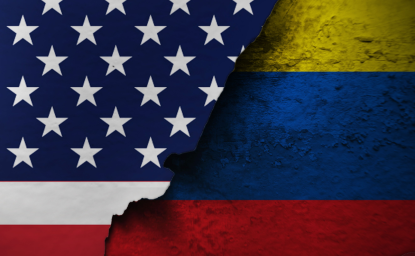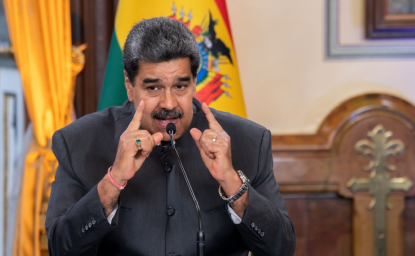In Mexico today, an individual vanishes – a daughter walking home from school, a husband returning from work, a young man out with his friends for the night – and no one seems to care. Their loved ones file the requisite paperwork, asking for an investigation, but no one else has noticed. This experience is multiplied by tens of thousands as the country recently surpassed 30,000 missing people, not to mention the more than 100,000 dead, since the Drug War was declared in 2006. How did disappearing become normal? How have law enforcement agencies and the judicial system failed to stem this tide of missing individuals?
The answer to these questions is simple: impunity. This is a country where only 2 percent of homicides end with a suspect being detained or charged. It is understandable, then, that Mexican citizens feel a general helplessness to stem the tide of violence. Nowhere is this more obvious than when someone goes missing. With a disappearance, there is no body and no sense of closure. This places the family in limbo and makes it easier for the government agencies to claim deniability. Perhaps your son was involved with a cartel? Perhaps your daughter ran away with a boyfriend? How do you know they are in fact missing? Denial is critical to official impunity and the normalization of disappearances. It is rooted in the divide between the Drug War and the Cold War. To devise policy prescriptions for stemming the rates of disappearances that move beyond the obvious moral outrage or the fact it violates human rights, it is critical to understand how this practice of “disappearing” people has been employed or sanctioned by the very institutions that were (and are) supposed to prevent it.
The modern practice of government forces “disappearing” insurgents grew out of the Cold War. Governments throughout the world and certainly in the Americas instructed their security forces to covertly eliminate so-called subversives – students, teachers, labor or rural activists – who threatened to destabilize the social order. Under the aegis of the “dirty war,” security agents could use unconventional methods to systematically and strategically repress citizens. The Cold War thus offered up both the rhetoric and the strategies by which to remove these “enemies” in the name of the larger social good.
Disappearing may have started as an unconventional tool during the Cold War, but it has grown to be indispensable in the arsenal of Mexico’s Drug War today. The government’s security forces and organized criminal networks, oftentimes populated by former or moonlighting agents from these same security forces, use this tool against their enemies. Countless innocent victims have been caught up in this war, including forty-three students going to a protest march in the state of Guerrero in September 2014 who have never been heard from since despite great efforts from their families and human rights groups.
In Mexico, the practice of disappearing began in the early 1970s, as security forces tackled emerging guerrilla forces, groups emboldened by the Cuban Revolution and intent on forcibly overthrowing the government. Security forces detained these individuals and tortured them in clandestine prisons, then relocating them to traditional prisons. Thus, the numbers of political prisoners dropped precipitously in 1975 and, as one former political prisoner recalled, guerrilla members “knew that if they picked you up, you would be killed or tortured and then[be] disappeared.” Disappearances could happen any number of ways. A prisoner transported to a military base off the coast in the state of Guerrero, is loaded up on a plane and thrown into the Pacific Ocean. Another prisoner is taken to a target practice range in the outskirts of Mexico City, his head hooded and identified by a number; two soldiers execute him by emptying several rounds from machine guns, leaving – in the words of one of these soldiers – very little to identify him as human. The government learned that it could easily and expediently make insurgents vanish under the banner of impunity and Cold War paranoia.
The disappearing of so-called subversives was known only fragmentarily, making it all the more ominous and intimidating. Much like today, it was their family members who clamored for attention at the gates of government buildings, while officials ignored the demands for justice or, at the very least, a body to bury. The absence of an effective, autonomous, and adequately funded truth commission similar to what we saw in Guatemala, Peru, or South Africa, means we do not know the full extent of the violence during Mexico’s “dirty war” in the 1970s. Estimates suggest anywhere between 1,200-3,000 disappeared or killed. Today’s figures are so much more daunting, both because they are known to have surpassed 30,000 and because there is no end in sight. No solution to this intractable crisis. No hope for the families of the disappeared.
In the same way that killing and torturing are learned, disappearing is an acquired skill. Members of the security forces began moonlighting for the drug cartels in the 1980s. After several members of the secret police were implicated in the killing of a U.S. DEA agent in 1985, the government was forced to disband – albeit briefly – the secret police in 1985. Yet this practice of straddling legal and extra-legal practices continued through the 1990s, culminating in the formation of Los Zetas. Today, Los Zetas is one of the largest organized criminal networks, specializing in trafficking of humans, drugs, organs, of kidnapping, and extortion. They are especially notorious for killing Central American migrants attempting to cross Mexico en route to the U.S. border, dissolving their bodies in barrels of acid or dumping them in mass graves. Like other government agents, Los Zetas applied their training by security forces to the needs of organized criminal networks.
At the end of the day, impunity is what has nurtured the longevity of disappearing as a strategy for dealing with internal enemies, be they of cartels or the government, though we cannot easily distinguish between the two. Agents in both legal and extra-legal worlds will continue to disappear their enemies because of an ineffectual judiciary, corrupt political system, and compromised security apparatus. The prevalence of disappearances stands as a testament to Mexico as a captured state, where organized criminal networks have hijacked government institutions and where officially-sanctioned practices that emerged out of the 1970s become routine.
Author

Mexico Institute
The Mexico Institute seeks to improve understanding, communication, and cooperation between Mexico and the United States by promoting original research, encouraging public discussion, and proposing policy options for enhancing the bilateral relationship. A binational Advisory Board, chaired by Luis Téllez and Earl Anthony Wayne, oversees the work of the Mexico Institute. Read more





